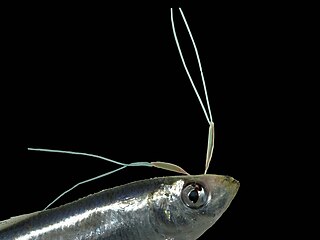
Copepods are a group of small crustaceans found in nearly every freshwater and saltwater habitat. Some species are planktonic, some are benthic, a number of species have parasitic phases, and some continental species may live in limnoterrestrial habitats and other wet terrestrial places, such as swamps, under leaf fall in wet forests, bogs, springs, ephemeral ponds, and puddles, damp moss, or water-filled recesses (phytotelmata) of plants such as bromeliads and pitcher plants. Many live underground in marine and freshwater caves, sinkholes, or stream beds. Copepods are sometimes used as biodiversity indicators.
Tantulocarida is a highly specialised group of parasitic crustaceans that consists of about 33 species, treated as a subclass of the class Hexanauplia. They are typically ectoparasites that infest copepods, isopods, tanaids, amphipods and ostracods.

Siphonostomatoida is an order of copepods, containing around 75% of all the copepods that parasitise fishes. Their success has been linked to their possession of siphon-like mandibles and of a "frontal filament" to aid attachment to their hosts. Most are marine, but a few live in fresh water. There are 39 recognised families:

The Cyclopoida are an order of small crustaceans from the subclass Copepoda. Like many other copepods, members of Cyclopoida are small, planktonic animals living both in the sea and in freshwater habitats. They are capable of rapid movement. Their larval development is metamorphic, and the embryos are carried in paired or single sacs attached to first abdominal somite.

Calanus is a genus of marine copepod in the family Calanidae. The genus was split in 1974, with some species being placed in a new genus, Neocalanus. The following species are recognised:

Poecilostomatoida are an suborder of copepods. Although it was previously considered a separate order, recent research showed it to be nested within the Cyclopoida
Shiinoidae is a family of parasitic copepods. The first species in the family to be described was Shiinoa occlusa, a single immature female of which was discovered on the fish Scomberomorus commerson, and described by Kabata in 1968. A second species, S. inauris, was found on Scomberomorus regalis and described by Roger Cressey in 1975, who also erected the family to hold the genus Shiinoa alone. A second genus was added in 1986, containing the single species Parashiinoa mackayi, which had been found on the fishes Pomadasys maculatus and P. argenteus. Nine species are now recognised in the two genera:
Clausiidae is a family of parasitic copepods of the suborder Poecilostomatoida, comprising the following genera:

Gelyella is a genus of freshwater copepods which are "surrounded by mystery". They live in groundwater in karstic areas of southern France and western Switzerland. The two species are the only members of the family Gelyellidae and, although previously placed in the order Harpacticoida, a new order, Gelyelloida, was erected for this family alone.

Clausidium is a genus of copepods that have been found in subtopical to temperate coastal areas along the Pacific, Atlantic and Gulf coasts of North America, the Pacific and Atlantic Coasts of South America, the Atlantic and Mediterranean coasts of Europe, the Atlantic coast of Africa, and the coast of India.

Pennellidae is a family of copepods, containing numerous genera, including:
Robertgurneya is a genus of copepods, containing the following species:
Metridinidae is a family of copepods, comprising three genera – Gaussia, Metridia and Pleuromamma. It has also been referred to as "Metridiidae", but following a petition to the International Commission on Zoological Nomenclature, that name has been restricted to the family Metridiidae Carlgren, 1893, based on the anthozoan genus Metridium. All species in the family can produce blue-green bioluminescence; the light is produced in glands, whose position varies between genera.
Pennella is a genus of large copepods which are common parasites of large pelagic fishes. They begin their life cycle as a series of free-swimming planktonic larvae. The females metamorphose into a parasitic stage when they attach to a host and enter into its skin. The males are free swimming. Due to their large size and mesoparasitic life history there have been a number of studies of Pennella, the members of which are among the largest of the parasitic Copepoda. All species are found as adults buried into the flesh of marine bony fish, except for a single species, Pennella balaenopterae which can be found in the muscles and blubber of cetaceans and occasionally other marine mammals, and is the largest species of copepod.
Eudactylinidae is a family of copepods most of which live as parasites on the gills of elasmobranch fishes; two genera lives on the gills of teleost fishes. The family Eudactylinidae contains the following genera:
Eudactylina is a genus of copepods that parasitise elasmobranch fishes. It contains the following species:

Lepeophtheirus pectoralis is a species of parasitic copepod from the northeast Atlantic Ocean, and the type species of the genus Lepeophtheirus. It is a parasite of flatfish, with the European flounder, the plaice, and the dab as the most frequent hosts. It feeds on the mucus, skin, and blood of the fish, with egg-producing females infecting the pectoral and pelvic fins of the host, while immature individuals and males are found on the rest of the body.
Archidactylina is a genus of copepods that contains only the species Archidactylina myxinicola, and is the only genus in the family Archidactylinidae. It is a parasite of the gill pouches of two species of hagfish found in Japanese waters, Eptatretus okinoseanus and Myxine garmani.
Peniculisa is a genus of marine parasitic copepods in the family Pennellidae.

Protosarcotretes is a genus of marine copepods in the family Pennellidae. Its type-species is Protosarcotretes nishikawai. This genus exhibits the most plesiomorphic states in the first to fourth legs of pennellids, and is differentiated from two closely related pennellid genera Sarcotretes and Lernaeenicus by the morphology of the oral appendages.









